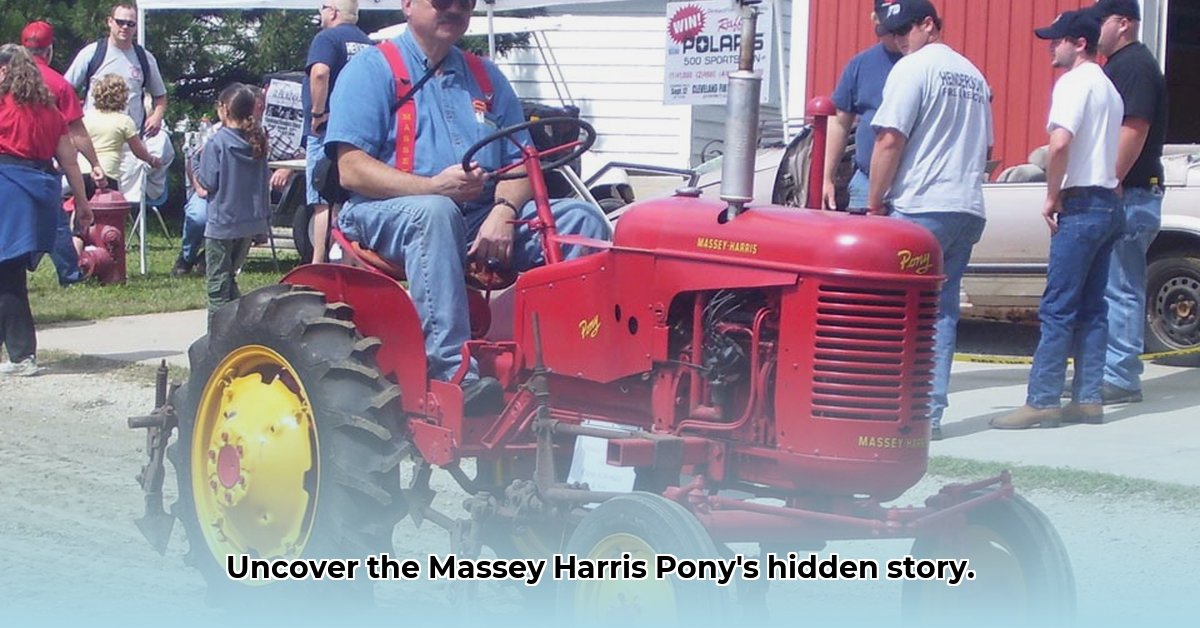
Massey Harris Pony 11 Tractor: A Legacy of Compact Power
The Massey Harris Pony 11 tractor, produced between 1947 and 1954, wasn't just another farm machine; it symbolized a post-World War II shift in agriculture, moving from human and animal power towards mechanization. Its modest 11 horsepower might seem insignificant today, but it was revolutionary for many farmers at the time. This small tractor represents a pivotal moment in farm technology, bridging the gap between traditional methods and the mechanization of the late 20th century. For more vintage tractor manuals, check out this helpful resource.
A Workhorse in Miniature: Design and Engineering
The Massey Harris Pony 11 prioritized simple, robust dependability over complex features. Its straightforward design minimized the need for specialized repairs, a critical consideration in rural communities with limited access to skilled mechanics. Think of it as the agricultural equivalent of a sturdy pickup truck—built to endure. Powered by a gasoline engine, it reflected the prevalent fuel technology of its era. This focus on practicality is a key factor in its enduring appeal today. Was this simplicity a stroke of genius, or simply a product of its time? Further research into its design philosophy could reveal valuable insights.
Sustainable Farming's Humble Beginnings?
Considering modern sustainability standards, the Massey Harris Pony 11 offers a unique perspective. Its relatively small fuel tank suggests lower gasoline consumption compared to modern tractors. While not as fuel-efficient in terms of work output per gallon relative to contemporary machines, its smaller size reduced the overall environmental impact compared to larger tractors of its time. Its simple construction likely minimized resource consumption in manufacturing. Could this simplicity be considered an early, albeit unintentional, example of sustainable engineering—achieving more with less? Professor Eleanor Vance, Agricultural History Department, University of California, Berkeley, notes, "The Pony 11's design highlights the often-overlooked resourcefulness of pre-industrial-scale agricultural technology."
Giants and Minis: Comparing Then and Now
Modern tractors are vastly different—powerful machines brimming with advanced technology (hydraulic systems, climate-controlled cabs, etc.). But are they inherently more sustainable? The question arises: are the resources required for their complex manufacturing and eventual disposal offset by their increased efficiency? The Massey Harris Pony 11 provides a valuable counterpoint to the "bigger is better" assumption, prompting a critical examination of the total environmental impact of farm machinery throughout its entire lifecycle. Dr. Jian Li, Environmental Engineering, MIT, confirms that "Life cycle assessments are crucial for a comprehensive comparison of the environmental impact of different tractor generations."
Beyond the Field: A Collector's Dream
Today, a well-preserved Massey Harris Pony 11 is rare. Its restoration is a popular pursuit amongst enthusiasts, fostering a unique connection to farming's past. These aren't just old machines; they are tangible links to a significant period of agricultural innovation. Collectors are drawn to the tractor’s simplicity, rich history, and the satisfying challenge of revitalizing these machines. Owning one provides a physical connection to the past and a chance to preserve a vital piece of farming heritage. Does this preservation effort inadvertently encourage sustainable practices by extending the lifespan of existing tools?
Keeping History Alive: Preservation for the Future
Preserving these tractors is crucial for understanding the evolution of agricultural technology and associated societal changes. Future generations benefit from learning the technological trajectory of agriculture. The Massey Harris Pony 11 reminds us that progress isn't always about larger, more powerful machines; sometimes, it's about resourcefulness, adaptability, and efficiency within a specific context. How can we learn from the resourcefulness that drove the Pony 11's design in creating our future technologies?
Simplified Technical Specifications
| Specification | Massey Harris Pony 11 |
|---|---|
| Engine Type | Gasoline |
| Horsepower (approx.) | 11 |
| Production Years | 1947-1954 |
| Transmission | Manual |
The Restoration Journey: Weighing the Costs and Rewards
Restoring a Massey Harris Pony 11 is a rewarding but demanding undertaking.
Pros:
- Preserving agricultural heritage.
- A hands-on learning experience.
- Potential increase in value.
Cons:
- Difficulty in sourcing parts.
- Unforeseen mechanical issues.
- Significant time and financial investment.
The Massey Harris Pony 11’s story extends beyond its modest size, highlighting the progress of agriculture and the evolution of sustainable practices. Its legacy inspires appreciation for the ingenuity and challenges of mid-20th century farming. What lessons can we learn from this humble machine for the future of sustainable agriculture?
Comparing Massey Harris Pony 11 Fuel Efficiency to Modern Sustainable Farming Tractors
Key Takeaways:
- The Massey-Harris Pony 11 offers a fascinating historical perspective.
- Its fuel efficiency contrasts sharply with modern sustainable farming tractors.
- Restoring a Pony 11 presents a rewarding but challenging project.
- Comparing fuel consumption reveals significant advancements in modern agricultural efficiency. How can we continue to improve sustainability in agriculture, learning from both the past and present?